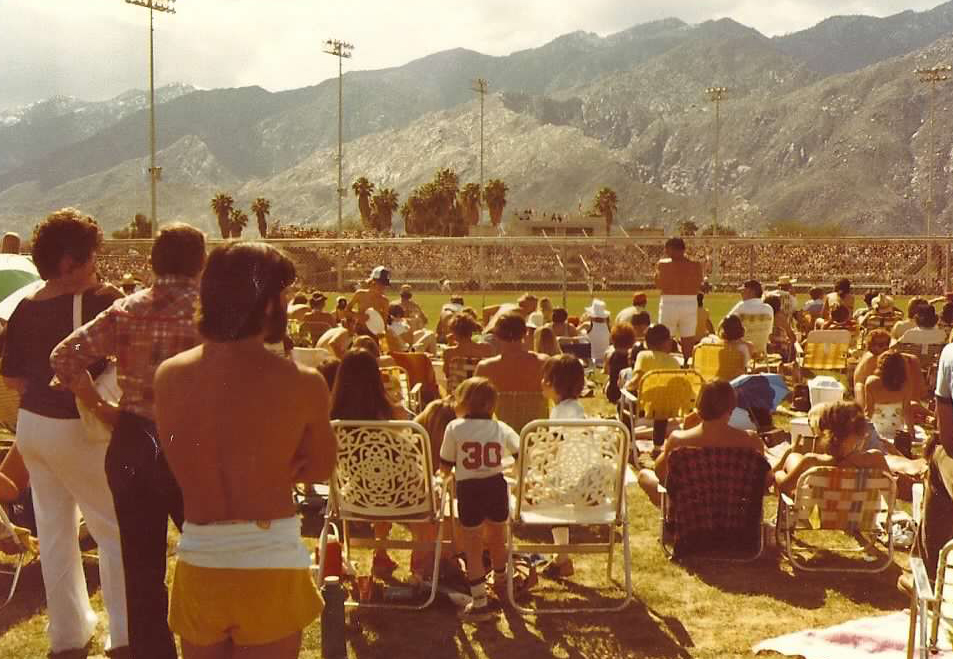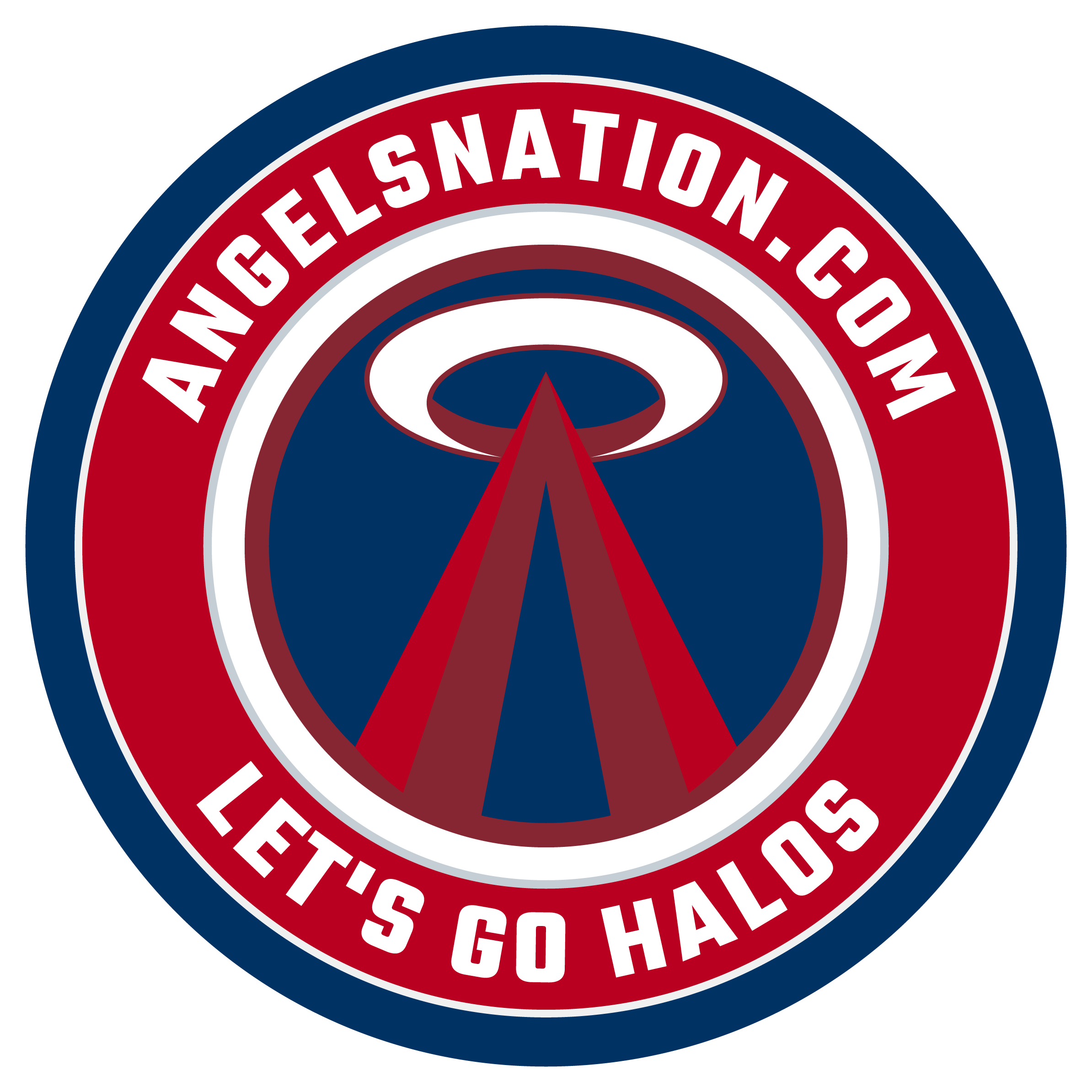Springtime in the Springs: Autograph Hunting
(One of our special series about the Angels’ memorable spring trainings in Palm Springs, CA — before the Cactus League and in honor of the club’s 60th MLB season).
by BJ Martin, angelsnation.com staff writer
The smell of Coppertone sunscreen, spilled draft beer, and steamed hotdogs was in the air as we sat back on our blankets, with a view of the snow-capped San Jacinto Mountains. And sun beaming off the metal seats surrounding the backstop of a small stadium ballpark called Angels Stadium.
Yes — before the MLB Anaheim Stadium became Edison Field, and then became Angel Stadium, in Palm Springs, California the former Polo Grounds was called Angels Stadium, too.
And it was the cozy spring home of the franchise for over thirty years, and a haven for thousands of baseball-loving kids like me.
My earliest memories as an Angels fan include weekend afternoons in Palm Springs with my brother, parents, and grandparents.
Memories and stories.
Stories like how, in Palm Springs one March after an Angels game, I also ended up accidentally “caddying” for the great “Mr Cub” — Ernie Banks, Hall of Famer.
But I’ll save that one until the end to keep y’all reading.
Those Palm Springs weekends were spent inside this square block in the scrubby desert — bordered by East Baristo Road to the north, South Pavilion Way to the east, Ramon Road to the south, and South Sunrise Road to the west.
The ballpark itself only consisted of less than 4,000 seats within the small concrete stadium. Outside the park was another park.
Inside the stadium, modest aluminum bleachers extended each way along the foul lines just beyond the infield. Later, some were added in right field.
So here was Major League Baseball in the most intimate setting of all inside Sunrise Park — a lush park that had some light exercise equipment, paved trails, a few basketball courts, and lovely spots to picnic prior to games between batting practice and first pitch.
We snacked on packed fried chicken and potato salad before the game in the shade of the palm trees — lots of palm trees.
My first visits were in March, 1979, and I clearly remember unfolding beach chairs and blankets beyond the chain-linked fence behind right field.
Looking through the outfield fence gave us a field-level view of the action and the players — from the Angels and the “Visitors” — and in the late innings they’d jog along the warning track in the long shadows after checking out early, work done, from games that wouldn’t count in the standings.
As a young fan and autograph seeker, I knew the secret spot: A key feature of the little ballpark was a single entrance and exit from each team’s locker room, which led right into the park behind the stadium entrance behind home plate.
The early ’80s Angels were playoff-hungry teams, and we kids were hungry to hit them up for autographs.
There were no private player parking lots behind fenced area. The players parked in lots across the park from the stadium, giving plenty of time for youngsters to rub elbows with our heroes.
Sometimes too close?
A very accommodating Doug DeCinces once showed a group of fans (including myself) the ballpoint-pen ink markings on his big forearms, like temporary tattoos. Packs of young, eager fans. holding out pens and baseballs, bubblegum cards or other stuff in DeCinces’ direction, had unknowingly scribbled all over the All-Star’s arms.
The smiling third baseman laughed it off, and he washed it off later.

A circular metal bike rack stood about thirty yards beyond the home plate entrance to the ballpark. One Sunday afternoon, about 30 minutes after a game ended, I saw superstar Reggie Jackson asking the fans to form a line for his autograph there.
Mr. October leaned back against that bike rack and he signed autographs from that spot until the very last kid in the line got the future Hall of Famer’s autograph.
Palm Springs was laid back like that in those days.
Future Angels were a big part of the picture, too. Can’t-miss prospects Gary Pettis and Dick Schofield would exit the ballpark together and sign their rookie or minor league baseball cards for the fans as they headed for their car and their dinner.
Palm Springs was the playground of Angel owner Gene Autry, and the Cowboy would exit the ballpark side-by-side with his fans, generously chatting, posing for precious photos, and signing autographs of his own. He was a star but loved his Angels and his fans.
Some some star players eluded us. Were they sneaky? There was a story, possibly an urban legend, circulating that some players (Fred Lynn, it was said) would allegedly avoid the autograph hounds by escaping the ballpark through the field and then climbing over the outfield wall to the safety of his car.
Whatever his secret, there was no doubt that Lynn, the Angels star centerfielder, had an uncanny knack of not being seen by fans after games. It’s funny now, but whatever the method, it worked. I never saw him.
But I saw most of the players. I was able to meet Angels’ legends Jackson, Rod Carew, and Don Sutton as they left the ballpark.
Visiting players were also a huge thrill. We met and casually chatted with Paul Molitor, Robin Yount, Ryne Sandberg, Andre Dawson and Tony Gwynn. All of them are currently enshrined in Cooperstown. I was lucky to meet them in Palm Springs.
Palm Springs was the setting of so many memories like this and more — memories that mold a lifelong baseball fan and now a bit of a baseball historian.

One afternoon, about ten minutes before first pitch, I saw the Brewers’ Paul Molitor along the third base line and politely asked for his autograph. He declined at that time — Molitor was preparing for the game — but he made sure to toss me a ball from the field over the ten-foot chain-link fence that separated us.
I caught it cleanly, and Molitor smiled.
The spring following the Chicago Cubs’ remarkable 1984 season, I recall encountering the late broadcast legend Harry Caray and GM Dallas Green and getting both of them to sign a team photo Fleer baseball card that I had previously had manager Jim Frey sign.
Today, I still have this card in my collection of memories from this magical period of my adolescent baseball fandom.
Prior to the 1986 season, I watched the Athletics and Angels putting on a “home run derby” of sorts during their batting practice sessions in Palm Springs. Here’s how that went down:
Oakland’s musclebound rookie Jose Canseco, prospect Mark McGwire, and veteran Dave Kingman took turns demolishing BP baseballs onto East Baristo Road.
But during the Angels’ BP, the home team weren’t to be outdone.
It was as clear as the blue sky that a phenomenon was heading to the Big A after that spring of ’86. It was marvelous to watch towering homers crash off the bat of fresh-faced rookie Wally Joyner towards the towering mountains.
Wally repeatedly cleared the center and left-center field walls in BP, and to everyone’s delight, homered in the game to follow.
It was clear there a battle was brewing between these sluggers when Oakland and the Angels would meet in the regular season.
Later in the decade, I would make the trek from Orange County to Palm Springs with my high school buddies for a more “mature” experience. We’d soak in the games at Angels Stadium in the daylight hours before cruising the wild streets of Palm Springs in a time in which it was also Spring Break mecca
By this time, the team and city had added a much larger grandstand in right-center field with boarded outfield walls with advertising.
I remember sitting in those outfield seats in late March as the Angels concluded their final series at the ballpark, before committing to plans to relocate to Tempe the very next season. Maybe my memories got hazy because I was a young man on “spring break,” or because it didn’t feel quite “the same.” But still the place to be.

I said I’d save the best of my Palm Springs memories for last, so here it is: My encounter with the with retired, Hall of Famer Ernie Banks.
Ernie Banks was with the visiting Chicago Cubs as a team ambassador, and in the early innings of a game, outside the locker room exits, a small group of kids and adolescents like myself were requesting his autograph.
He was accommodating all of these requests and I was the last of the seekers to reach Mr. Cub.
At that point, Banks told me he’s sign by baseball if “I did him a favor.”
I said “Sure, Mr. Banks” and followed Banks about a hundred feet or so from the locker room exit to a sedan parked in the nearby parking lot.
The Hall of Famer popped open the trunk and there were his golf clubs, in a custom pro-style golf bag that said: “Mr. Cub.”
Mr. Banks politely requested that I caddy his bags from his vehicle into the Cubs’ locker room entrance in exchange for that requested autograph.
And boy, did I! … I gladly did the honors and Ernie Banks obliged me with his signature on a baseball for me, as well with a couple dozen other autographs.
That was something. But those days had to move ahead.
The Angels moving to Tempe made all the sense in the world. The Angels were the oddballs of spring training, playing so far away from the Phoenix-Tucson region, despite the wonderment of Palm Springs.
The Angels’ move meant that only the Padres’ border-town facility in Yuma, Arizona was apart from the Phoenix area, and even Yuma was still a couple hours’ drive closer to the metro areas of Arizona that hosted the other Cactus League teams.
It’s so different now. Tempe’s Diablo Stadium has provided another set of wonderful memories for another generation of Angels fans.
But for those of us who were able to experience Angels spring trainings, so close to Orange County, and in the oasis setting of Palm Springs — well, we will always cherish the memories of those 90-degree afternoons in the Coachella Valley, in the little park in the desert, rooting on our Halos heroes.
— BJ Martin is a marketing professional, Angels historian, journalist, SABR and IBWAA member and podcaster.
Follow BJ Martin’s twitter feed and listen to his podcasts at: @_HaloLife. (You’ll frequently hear Angels Nation editor Stu Matthews as a guest on his special podcasts).



